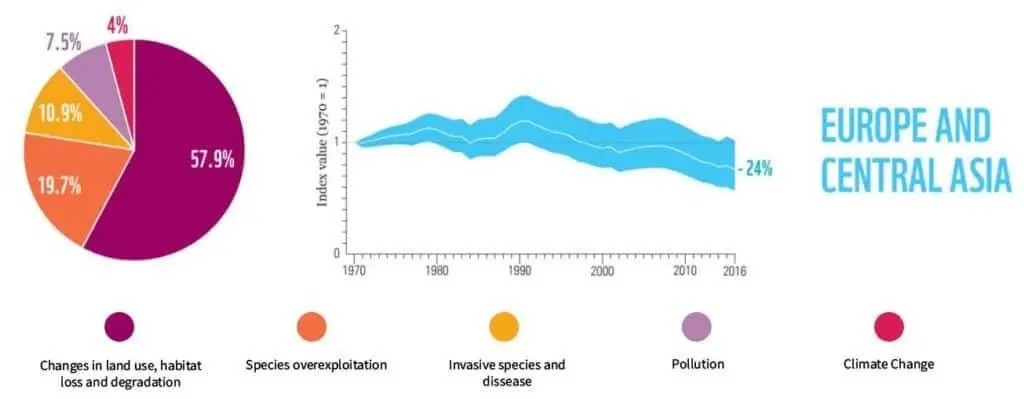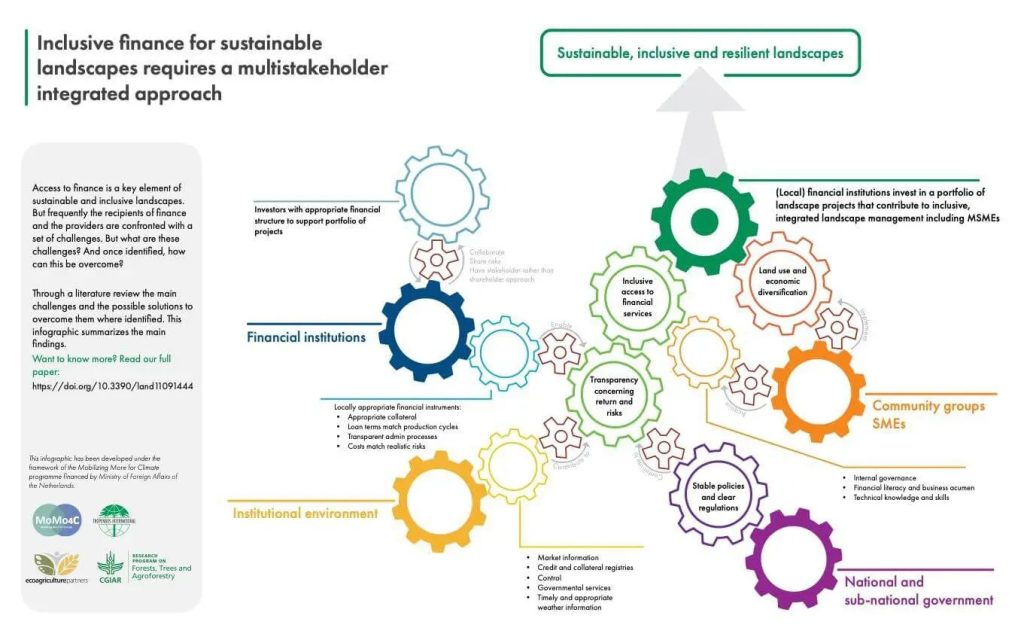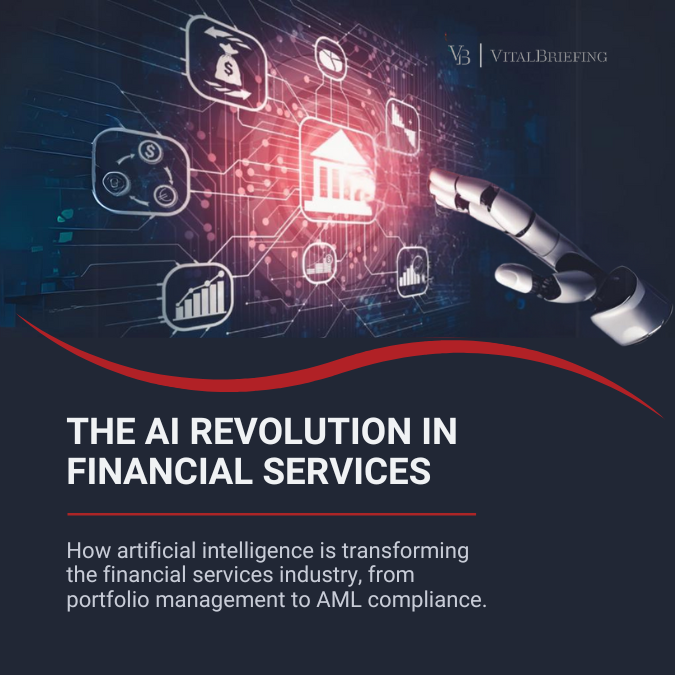The GLF – Luxembourg Finance for Nature 2023 6th Investment Case
The GLF-Luxembourg Finance for Nature conference on March 7th pondered the question, “what comes next?”
The financial sector is a significant contributor to the climate and biodiversity crises, but it can also be a solution if we understand the challenge and are prepared for it.
Respectful usage of our natural world provides solutions, but do we have the necessary mindset shift to seize the opportunity in emerging markets and drive innovation forward?
The Luxembourg House of Financial Technology – LHoFT covered the event in search of answers.
Introduction
From Cameroon and Zambia to Indonesia, the Global Landscape Forum beckoned investors, builders, and doers to virtually roam the earth during the Luxembourg Finance for Nature 2023 event. Yet, their mission was to seek and fund transformation and innovation, to fulfill the Sustainable Development Goals and the Paris Climate Agreement’s requirements.
Amidst a world where Earth’s nine planetary limits are endangered, and the loss of biodiversity is labeled a “high risk”, securing resilience has turned into an urgent matter. Current extinction rates soar to record heights, and scores of species confront a near-term danger of vanishing. Natural dwellings continue to be transformed, and freshwater reserves dwindle, compounding the mounting stress on both ecosystems and humanity.
The Luxembourg House of Financial Technology chronicled the event with the aspiration of disseminating insights and wisdom from change makers and investors and gaining a glimpse into the backstage factors affecting the sustainable finance industry.
This analysis draws inspiration from the Dragon’s Den event at the conference, where entrepreneurs pitch their business ideas to a panel of investors known as “dragons.” We face ourselves powerful beasts: climate change and biodiversity loss, which threatens our very existence. Yet, there is hope. Finance can provide a solution to secure a sustainable future, and we must be willing to face this challenge head-on, just as the brave knights of old met the dragons of legend in battle.
Derisking Fiery Threats
Her Excellency Joëlle Welfring, Luxembourg’s Minister for Environment, Climate, and Sustainable Development, described the present state of affairs in this manner:
“We all know that we are stuck in multiple crisis, foremost climate change biodiversity loss, and pollution, and the decisions that we take or do not take today will define the future of our planets and its entire living species.”
According to the National Geographic, biodiversity “refers to the variety of living species on Earth, including plants, animals, bacteria, and fungi. While Earth’s biodiversity is so rich that many species have yet to be discovered, many species are being threatened with extinction due to human activities, putting the Earth’s magnificent biodiversity at risk”.
The world’s flora and fauna diversity is gradually fading away, leaving behind a barren landscape of emptiness and loss. In Europe and Central Asia, the 2020 WWF Living Planet Report states that just 23% of species and 16% of habitats are thriving. Alarming still, 1,677 of the 15,060 European species are on the brink of vanishing forever.

Source: WWF Living Planet Report 2020
Financing sustainability is not granting… And not granted.
“We are a bank and we do not provide grants. That is not our general core business.” – Floor van Oppen, Fund Manager of the Dutch Development Bank Infrastructure Development Fund, and the Access to Energy Fund
Let’s take a moment to consider this: although they are fully cognizant of the grave situation and the perils of losing biodiversity, investors still require some reassurances before they will invest in nature-based solutions.
Nature-based solutions (NBS) are those that employ nature to tackle social and environmental obstacles, such as drought, hunger, or climate change. They include restoring damaged forests or lands, building green infrastructure like wetlands or green roofs, and safeguarding ecosystems and biodiversity.
The concept of derisking NBS is about minimizing the uncertainty and financial jeopardy that comes with investing in these ventures, to make them more appealing to investors. To accomplish this, one must evaluate and control the hazards and advantages of nature-based solutions, considering their potential economic returns, and crafting systems that ensure equitable distribution of costs and benefits among stakeholders.
Suppose a company desires to invest in the rehabilitation of a depleted forest. In that case, it may be cautious due to the inherent dangers linked to the project, such as the possibility of the project collapsing or not being able to market the forest’s goods.
Reducing risk would necessitate identifying these threats and devising ways to alleviate them, such as selecting the appropriate tree species for the soil or arranging long-term contracts with prospective customers.
By reducing financial jeopardy in NBS, investors are more prone to lend their support, thereby encouraging greater investment in natural resources and a future that is more sustainable.
At the core of this concept, we discover the prerequisites of “quality deal flow,” a term frequently employed in the investment realm to denote the stream of investment prospects that possess high quality and correspond to the investors’ investment objectives. Investment opportunities must satisfy a certain set of criteria to pique interest, including:
- Conformance with said investment objectives,
- Emerging from a sector or industry related to the investor’s expertise or interest,
- Potential to generate desirable returns, whether through growth or a liquidity event such as an acquisition or IPO,
- A clear exit strategy, allowing investors to eventually divest their stake in the company and realize a return on their investment.
Missing the Link to the Real Economy

Source: globallandscapesforum.org
During the session of the Opening Plenary, the aforementioned infographic condensed the primary findings from the literature review “Access to Landscape Finance for Small-Scale Producers and Local Communities.”
The examination highlights the aspects that impede or enable inclusive financing for small to medium-sized enterprises and projects across sectors, contributing towards sustainable landscape. High perceived risks by finance providers and their customers are one of the most prevalent obstacles.
Another component stands out from the others as particularly important: access to financial services. This is closely tied to the lack of existing pipelines.
In the context of investing in Nature-Based Solutions, a “pipeline” refers to a structured process conducted by investors for identifying, assessing, and evaluating potential investment opportunities in those projects. Divided in several stages, pipelines typically start by identifying potential investment opportunities with the help of local communities, non-governmental organisations, and other stakeholders. The investment areas are then screened to determine their viability, potential risks and returns and alignment with investor goals and values, along with an evaluation of their environmental and social impacts. Once the necessary investigations are complete, the fitting investment strategy and vehicle are arranged, the investment is put forward, and the NBS project is supervised and assessed to confirm its desired environmental and financial results, including frequent reports on its performance.
During his participation in the panel on “Navigating the tricky terrain of NBS and blended finance”, Ebenezer Arthur, CEO of Wangara Capital Partners, lamented the absence of adequate pipelines in West Africa, East Africa, Latin America and South East Asia markets, where “most of the ideas and Innovations tend to struggle” in obtaining additional financing. Confined to their incubation underground, the seeds cannot blossom; an “ecosystem approach” that prioritizes local stakeholders, long-term sustainability, and resilience is therefore required.
To properly support economic activity and livelihoods, build resilience against future challenges, and mitigate environmental risks, investors must undergo a mindest shift and learn the intricacies of NBS investments. This is crucial for ensuring the success of such investments.

Source: MidJourney
Taming The Dragon
In this segment, we shall scrutinize, point by point, the measures that various actors can implement to curb the rampant biodiversity loss and its attendant risks in the pursuit of funding. The champions of this endeavor are none other than the change makers and solution providers, the private sector, and, of course, governments around the globe.
Change Makers: The Quest for Quality Dealflows
Reforestation, sustainable agriculture, wetland restoration, and green infrastructure projects may appeal to investors seeking quality dealflows in various ways:
- Alignment with sustainable finance requirements and investor values: Increasingly, investors concentrate on investing in projects that align with their investment’s preferences, should those be influenced by voluntary reporting initiatives such as the Task Force on Climate-Related Financial Disclosure, or comply with mandatory reporting such as the European Union Sustainable
- Finance Disclosure Regulation. In this sense NBS provide investors with a way to earn returns while supporting positive environmental outcomes.
- Potential for attractive returns: NBS projects can offer attractive returns for investors, particularly for those who prioritize long-term investments. For instance, a reforestation project may generate returns from the sale of carbon offsets over several years.
Potential for risk diversification: Investing in NBS projects can serve as a way for investors to diversify their risk across different asset classes and geographic locations. For instance, a portfolio of sustainable forestry investments may provide diversification benefits for an investor with a more conventional equity portfolio.
Social and environmental impact: NBS projects can offer investors the chance to have a positive impact on communities and the environment, which may be crucial for those seeking investments with a purpose beyond financial returns.
As a member of the panel tasked with grappling the intricacy of channeling sustainable climate finance to the Global South, Floor van Oppen emphasized the necessity for solution providers to converse in a “financial language,” as investors require a clear understanding of the business case and anticipated returns on investment. She lamented that often, parties approach bankers and potential funders with an impressive impact story, hoping that financial experts will assist in crafting their business case. “This is not something we can do”, she asserted, “we don’t have enough people to do that.”
Governments: Converging the Streams of Funding
The disappearance of biodiversity wreaks havoc on our ecosystems, economies, and societies, imperiling our capacity to attain sustainable development and cater to the requirements of forthcoming generations. Establishing a worldwide biodiversity network is imperative for safeguarding biodiversity and ensuring the lasting sustainability of our planet. Such a network can aid us in tackling the intricate and interrelated difficulties that our ecosystems, economies, and societies face and contribute to shaping a more resilient and fairer world.
In this dire challenge, it is incumbent upon governments to serve as facilitators and regulators.
Jan Willem den Besten, expert in conservation policymaking and finance, presented research commissioned by the Ministry of Agriculture, Nature, and Food Quality of the Netherlands government. The objective of this project was to advance the Global Biodiversity Framework and proffer proposals for national biodiversity strategies and action plans, as follows:
- Facilitate alignment of financial flows for biodiversity, climate, land restoration and economic development through cross-sectoral and multi-stakeholder policy coordination.
- Create spatially explicit, place-based plans that include biodiversity conservation in relation to other sustainable development goals.
- Promote finance models that support multiple projects with synergies for biodiversity and sustain action over a long-time horizon.
- Mobilize private investment within integrated multi-sector, place-based development plans that benefit biodiversity.
- Strengthen landscape-level institutions for long-term collaborative finance planning and implementation.
- Develop technical guidance and capacity developments for countries.
The Private Sector’s Call to Lead the Charge
In his keynote address for the Opening Plenary “How do we reach the sustainable finance tipping point?”, Dr. Robert Nasi, Director General of the Center for International Forestry Research, explained that “for an investment of 800 million dollar in a forestry program, we have managed to achieve the protection of about 100 million hectares, 70 gigaton of avoided CO2 emissions, and the restoration of about 25 million hectares of land. If you add all these […] they translate into 240 billion dollars in economic returns avoided losses”.
All in all, NBS endeavors can lead to economic gains and avert losses by offering a plethora of advantages that foster sustainable development and diminish risks to the environment and humanity. But how so? Let us delve into a few examples.
- Risk mitigation: Investment in natural infrastructure projects can mitigate the risk of harm or loss resulting from natural disasters, such as floods, storms, or landslides, and prevent the expenses linked to damage to property, infrastructure, and other assets.
- Heightened productivity: Inventive projects can increase the productivity of land and water resources, leading to greater yields and improved livelihoods for local communities, reducing the need for costly and polluting inputs like pesticides and fertilizers.
- Better water quality: Wetland restoration can enhance water quality and decrease the need for expensive water treatment measures, benefiting municipalities and other entities responsible for water management.
- Carbon capture: Reforestation and afforestation can capture carbon from the atmosphere, generating carbon credits that can be sold on carbon markets and generate revenue for investors and project developers.
- Ecosystem services: NBS can promote economic activities such as agriculture and tourism through various means, including pollination, nutrient cycling, and regulation of the hydrological cycle.
By supporting nature-based solutions, corporations and investors can promote favorable environmental outcomes, generate financial returns, and fortify resilience to forthcoming obstacles.
- Education for investors and communities (smallholder farmers and suppliers across the value chain)
- Aligning with the convergence towards an ESG world
The Collaboration
As I elaborated in my previous article, “Connecting Impact Investors with Profitable Nature Projects,” resolving the enduring $3.5 trillion annual financing shortfall to realize the UN Sustainable Development Goals necessitates collaboration among private sector players. A more coordinated and efficient approach is urgently required.
No individual actor can tackle the challenges of a sustainable world alone. Collaboration enables diverse actors to share accountability for achieving sustainability objectives, pooling their resources and expertise to address multifaceted problems. This way, investors, banks, companies, and other stakeholders can drive systemic change and foster greater impact.
This approach allows to mitigate risks associated with sustainability and climate change. For example, by sharing data and insights, private sector entities can better comprehend climate risks and formulate strategies to manage them effectively.
Collaboration can also fuel innovation in sustainable finance by sharing knowledge and exchanging best practices across industries and sectors. By joining forces, private sector actors are enabled to devise novel approaches and solutions.
Finally, by cooperating to develop common standards, metrics, and reporting frameworks, private sector actors can establish a more transparent, consistent, and efficient market for sustainable finance.
The ESG Convergence
The world is coming together, slowly but surely, with Environmental, Social, and Governance (ESG) concerns taking center stage in regulatory and mandatory reporting aspects.
This movement is driven by various factors, including the growing demand for sustainable finance and investors’ desire for transparency and accountability. Governments and regulatory bodies are stepping up with regulatory initiatives, and international standards and frameworks like the Global Reporting Initiative (GRI), the Sustainability Accounting Standards Board (SASB), and the Task Force on Climate-Related Financial Disclosures (TCFD) are promoting best practices for ESG reporting.
Furthermore, institutional investors and asset managers are pushing companies to disclose their ESG performance and risks. As explained by Bhaskar Chakravorti, Senior Associate Dean of International Business & Finance at The Fletcher School at Tufts University, “with the public declarations by many companies to help with the [UN sustainable developments] goals, there is likely to be competitive pressure. Some companies could get a jumpstart in their industry in organizing partnerships and even positioning themselves as leaders in sustainable development using the [United Nations Sustainable Development] goals as a branding anchor. Being slow to act could lead to the risk of being left out of these relationships and a source of competitive disadvantage from a brand equity perspective”.
Conclusion: The Tipping Point
“We’re here to try to find ways to reach a tipping point for sustainable Finance; but the Amazon has already its own tipping point and unfortunately, we are very close to reach that one. […] If we lose 20 to 25% of the Amazon [rainforest] tree cover, it will lose its resealing capacity to absorb carbon and will become a carbon source, [changing] our environment to a savannah.” – Dr. Ayesha K. Khan, Regional Managing Director at Acumen
The deforestation tipping point is a crucial threshold beyond which substantial deforestation, primely driven by agricultural expansion, logging, and infrastructure development, could trigger an abrupt and possibly permanent loss of forest cover and biodiversity. This could also initiate a downward spiral of degradation, where degraded forests are more vulnerable to fires, droughts, and other disturbances.
During the plenary session, Dr Robert Nasi articulated in resolute terms the challenges confronting us and the requisite solutions for triumphing over the forthcoming, multilayered crisis: “we know that the financial sector has been a key driver responsible to the multiple crisis that we are facing, but we also know that the finance sector has the potential to be an important part of the solution of this crisis; solving, mitigating or adapting to the major crisis that we are facing, namely climate change, biodiversity loss, growing inequity, inadequate food system, will require some massive up-front investment and sustained financing before we reap the benefits for the environment.” He proceeded: “we know that the possible solutions for this above-mentioned crisis are those that will induce a positive tipping point if applied at scale, like moving out of a fossil fuel-based economy into a circular bioeconomy; removing perverse incentive, reducing inequities, conserving, and restoring ecosystems. For all these political will and investment are needed at all scales.”
At the GLF – Luxembourg Finance for Nature 2023 event, the goal was to raise awareness and funding for innovative Nature-Based Solutions that align with sustainability objectives. To improve their access to financial services, NBS must think in financial terms and minimize risk. Conversely, investors must alter their mindset and understand NBS investments and their complexities to mitigate environmental hazards and biodiversity loss.
A concerted effort is urgently needed to promote sustainable development, generate financial returns, and increase resilience. Sustainable future concerns are becoming more prevalent than ever before, and immediate action is crucial to prevent reaching the tipping point of irreversible harm to our planet.
“We can if we really want to. The question that we must ask is: do we want it?” – Dr Robert Nasi
Within the LHoFT: Seeds of Change
Pelt8 – The Shield Shaped Leaf

The European Union boasts of three significant regulations concerning sustainability disclosure: the EU Taxonomy, the Corporate Sustainability Reporting Directive, and the Sustainable Finance Disclosure Regulation (SFDR). These regulations were established to promote transparency, prevent greenwashing, and direct investments towards more sustainable products, businesses, and investments.
Pelt8, member of the LHoFT and winner of the 2022 Catapult: Kickstarter program, offers an innovative solution to make sustainability reporting simple and auditable. Their platform automates sustainability reporting and helps collect data while calculating sustainability reports and data collection emissions. The platform ensures clean data collection, traceability, and allows stakeholders to stay current with regulatory changes and reduce their audit costs.
To learn more about Pelt8 and their sustainability reporting platform, visit their website at www.pelt8.com.
Written by Oriane Kaesmann
Header image generated on Midjourney

